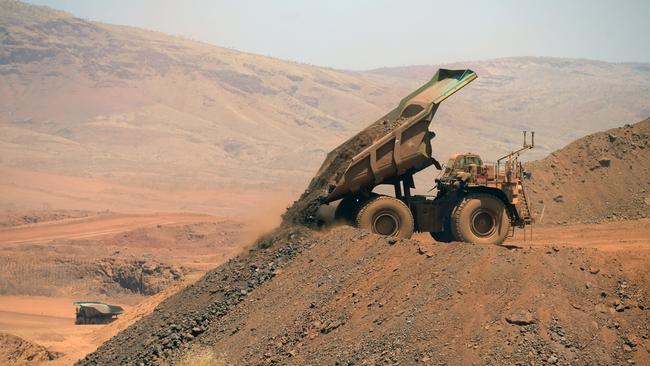Rio Tinto says Chinese economy facing property oversupply headwinds
The mining heavyweight has warned shareholders about production costs after a rain-hit end to 2024.

Rio Tinto faces more challenges with the West Australian iron ore mines that provide the lion’s share of group earnings, as it continues to ship higher volumes of lower-grade material to steelmakers in China.
The company was forced to draw down on mine stockpiles towards the end of 2024 during what is typically the most productive quarter for iron ore operations in the Pilbara.
Heavy rain flooded some mining pits, forcing Rio to eat into stockpiles it prefers to build up in the December quarter, with the period from January to April considered a higher risk for disruptions caused by cyclone activity.
Rio warned iron ore production costs for 2024 would be at the higher end of guidance, based on lower output and inflation outstripping internal expectations.
It is understood the biggest contributing factor to inflation was labour costs, which have not moderated in iron ore to the extent they have in the WA gold industry, despite thousands of job losses through nickel and lithium mine closures in 2024.
On the global economic outlook, Rio said inflation was moderating and growth stabilising but risks posed by geopolitical tensions and persistent labour shortages remained.
Rio, which believes iron ore demand has peaked but will remain strong, said the Chinese economy provided mixed signals in the last three months of 2024.
“China’s economic growth drivers continue to shift from the property sector to advanced manufacturing and new technologies,” it said.
“It still faces headwinds from an ongoing property market oversupply.”
Rio said the US economy, in particular the tech sector, had outperformed other developed economies and its outlook remained stable in the countdown to president-elect Donald Trump taking the reins.
Under the leadership of chief executive Jakob Stausholm, Rio is making big bets on lithium and copper. It has predicted sales of lithium could make up 13 per cent of its earnings over the longer-term under plans to become less reliant on iron ore.
The Pilbara iron ore operations were hit rainfall up to five times the historic average in the December quarter, which compounded issues with the declining quality of the product from ageing mines.
The mines produced 86.5 million tonnes in the three-month period, down 1 per cent on the same time in 2023, as the iron ore price slid by 8 per cent.
Rio said productivity gains mostly offset the depletion and the impact of heavy rain, but it would need to focus on regaining pit health in the first quarter of 2025 after the drawdown on mine stocks.
It said 2024 unit cash costs were expected to be in the upper half of $US21.75 to $US23.50 per tonne guidance.

Rio shipped 328.6 million tonnes of iron ore from its Pilbara ports in 2024, in line with guidance of 323 to 338 million tonnes, which remains unchanged for 2025.
The company is reviewing its iron ore product mix as it sends increasing volumes of lower-grade material, known as SP10, from the Pilbara and has flagged blending Australian and African product at ports in China.
The blending option will be open to Rio once its high-grade Simandou mine in Guinea starts production.
Rio received a realised price of $US83 per tonne for Pilbara iron ore in the December quarter, which was 4 per cent below consensus forecasts.
RBC said a contributing factor was the fact that lower grade SP10 volumes made up 25 per cent of shipments, compared to 19 per cent in the first three quarters of 2024.
Simandou reached another milestone on New Year’s Day when the first ore was crushed, with the mine on track to begin producing small volumes towards the end of 2025 and ramp up over 30 months to annual capacity of 60 million tonnes. Rio’s share of production will be 27 million tonnes per year.
Rio said its Pilbara iron ore guidance was subject to the timing of mining approvals and Indigenous heritage clearances, and it expected shipments of lower grade material to remain elevated until it could deliver new mines.
Iron ore boss Simon Trott and his Pilbara team face the task of delivering a replacement mine each year until the end of the decade, while at least maintaining current production and keeping a lid on costs.
Construction of the Western Range mine is almost complete and Rio expects it to produce first ore before June 30. Of its other mine replacement projects, Greater Nammuldi continues to run behind schedule.
Although it was hit by heavy rainfall in the December quarter, one of Rio’s other problems in the Pilbara is water supply.
It has started work on a $US395m desalination plant to supply port operations at Dampier, in a move aimed at reducing extraction from the Bungaroo aquifer to sustainable levels.
Rio confirmed it was considering building a second desalination plant as traditional owners, represented by the Yindjibarndi Aboriginal Corporation, pressure the WA government to slash groundwater extraction in a region near the Millstream Chichester National Park.




To join the conversation, please log in. Don't have an account? Register
Join the conversation, you are commenting as Logout